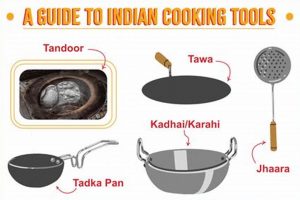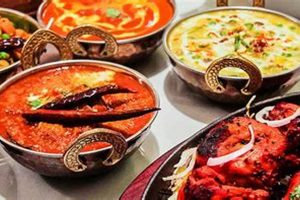Dietary intake from the Indian subcontinent can provide substantial amounts of essential macronutrients crucial for bodily functions. Sources of these nutrients often include legumes, dairy products, and certain grains, contributing significantly to overall nutritional well-being. For example, dishes featuring lentils, chickpeas, or paneer represent concentrated sources of these vital compounds.
Adequate consumption of such nutrients supports muscle development, tissue repair, and enzyme production. Historically, traditional Indian diets have incorporated these sources, reflecting an understanding of their value in maintaining health and vitality. This approach provides a sustainable way to ensure sufficient intake of essential building blocks for the body.
The subsequent sections will explore various aspects of meal planning, specific ingredient choices, and recipes that exemplify approaches to maximizing this specific nutrient intake within the framework of Indian cuisine. This will include analyses of both vegetarian and non-vegetarian options, as well as consideration of portion sizes and meal timing.
Maximizing Protein Intake in Indian Cuisine
The following guidelines offer practical strategies for increasing protein consumption through informed food choices and meal preparation techniques within the context of Indian culinary traditions.
Tip 1: Prioritize Lentils and Legumes: Incorporate a variety of dals (lentil-based dishes), such as masoor dal, toor dal, and chana dal, into daily meals. These are excellent sources of protein and fiber. Consume at least one serving daily.
Tip 2: Utilize Dairy Products Strategically: Dairy, including paneer (Indian cheese), yogurt (dahi), and milk, contributes significantly to protein intake. Include paneer in vegetable dishes or consume yogurt as a side dish. Opt for full-fat versions for increased satiety.
Tip 3: Incorporate Nuts and Seeds: Almonds, cashews, and pumpkin seeds provide supplemental protein and healthy fats. Use them as toppings for dishes or consume them as snacks between meals. Exercise portion control due to their caloric density.
Tip 4: Consider Non-Vegetarian Options: For those who consume animal products, chicken, fish, and eggs are efficient sources of protein. Integrate them into curries, stir-fries, or other preparations, ensuring proper cooking to eliminate foodborne illnesses.
Tip 5: Combine Protein Sources: Complement incomplete protein sources, such as grains, with legumes to create complete protein profiles. Combine rice with dal or roti (flatbread) with chickpea-based dishes.
Tip 6: Enhance Meals with Soy Products: Soybeans and soy-based products like tofu and soy granules offer plant-based protein alternatives. Incorporate them into curries or use them as a meat substitute in traditional recipes.
Tip 7: Optimize Meal Timing: Distribute protein intake evenly throughout the day. Consuming protein-rich meals at breakfast, lunch, and dinner supports satiety and muscle protein synthesis.
Tip 8: Mindful Portion Sizes: Even with protein-rich ingredients, appropriate portion control is essential for overall dietary balance and weight management. Adhere to recommended serving sizes to avoid excessive calorie consumption.
By adhering to these guidelines, individuals can effectively increase protein intake while enjoying the diverse flavors and culinary traditions of Indian cuisine. This approach supports overall health and well-being through informed dietary choices.
The subsequent sections will offer specific recipes and meal planning strategies that further exemplify these principles, providing a practical guide to implementing these tips in daily life.
1. Legume Variety
The diversity of legumes within Indian cuisine is a primary factor determining the feasibility of achieving high protein intake through vegetarian dietary patterns. This variety contributes significantly to the availability and accessibility of plant-based protein sources.
- Protein Content Variations
Different legumes possess varying protein concentrations per serving. For instance, soybeans and lentils generally exhibit higher protein content compared to kidney beans or chickpeas. The selection of legumes based on protein content directly influences the overall protein density of a meal. Dishes employing lentils as a primary ingredient, such as Dal Makhani, provide a substantial protein source due to the legume’s inherent protein concentration.
- Amino Acid Profiles
Legumes offer diverse amino acid profiles, though individual legumes may be incomplete protein sources, lacking sufficient quantities of certain essential amino acids. Combining various legumes throughout the day or within a single meal can complement these deficiencies, creating a complete protein profile. A mixed lentil soup containing multiple legume types improves overall protein quality compared to single-legume preparations.
- Digestibility and Nutrient Absorption
The digestibility of legumes varies depending on preparation methods and individual physiological factors. Soaking and cooking legumes thoroughly can improve digestibility and nutrient absorption. Sprouting legumes can also increase nutrient bioavailability and reduce anti-nutritional factors that may inhibit protein absorption. Traditional Indian cooking methods often incorporate these techniques to maximize nutrient uptake.
- Culinary Versatility
The wide range of legume types allows for culinary versatility in preparing high-protein meals. Legumes can be incorporated into soups, stews, curries, salads, and snacks. This versatility facilitates dietary adherence and makes it easier to consume adequate protein on a regular basis. Chickpea-based dishes, such as Chana Masala, and lentil-based preparations, such as Dal Tadka, illustrate the diverse applications of legumes in Indian cuisine.
The strategic selection and preparation of diverse legumes within Indian cuisine are crucial for optimizing protein intake, particularly for individuals following vegetarian or vegan diets. Understanding the specific protein content, amino acid profiles, and digestibility of various legumes allows for the creation of nutritionally balanced and palatable meals that support overall health and well-being.
2. Dairy Integration
Dairy products play a significant role in augmenting protein content within Indian dietary patterns. Their integration into traditional recipes and modern culinary practices impacts the overall macronutrient profile of meals.
- Direct Protein Contribution
Dairy items such as paneer (Indian cheese), yogurt (dahi), and milk are concentrated sources of protein. Their consumption directly elevates protein levels within a dish. For example, a paneer-based curry inherently possesses a higher protein content compared to a similar vegetable curry without paneer. This direct contribution is a primary reason for the frequent use of dairy in vegetarian Indian cuisine.
- Amino Acid Profile Enhancement
Dairy proteins contain a complete amino acid profile, meaning they provide all essential amino acids necessary for human health. When consumed alongside plant-based protein sources, such as legumes or grains, dairy can complement their amino acid profile, improving the overall quality of the protein consumed. This is particularly relevant for vegetarians seeking to optimize their protein intake.
- Bioavailability Considerations
Dairy proteins generally exhibit high bioavailability, meaning the body can efficiently digest and absorb the amino acids they contain. This efficient absorption makes dairy a reliable source of protein, contributing effectively to the body’s protein requirements. The form in which dairy is consumed (e.g., liquid milk versus solid cheese) can influence digestion rates, but the overall bioavailability remains high.
- Culinary Versatility and Acceptability
Dairy products possess significant culinary versatility, allowing for their incorporation into a wide range of dishes, from savory curries to sweet desserts. This versatility increases the likelihood of regular consumption and enhances dietary adherence. Furthermore, dairy is culturally acceptable and widely consumed in many regions of India, making it a practical and readily available source of protein for a large segment of the population.
The strategic incorporation of dairy into Indian meals serves as a reliable method for boosting protein intake. By understanding the protein content, amino acid profiles, bioavailability, and culinary versatility of dairy products, individuals can effectively leverage these resources to meet their dietary protein needs within the context of traditional Indian cuisine.
3. Nutrient Combinations
The macronutrient intake depends critically on complementary pairings of foods. The availability of adequate macronutrients in the Indian diet frequently hinges on combining sources that, individually, may not offer complete nutritional profiles. The pairing of legumes with grains exemplifies this principle. While grains provide carbohydrates and certain amino acids, they may lack sufficient lysine. Legumes, conversely, often possess an abundance of lysine but may be limited in methionine. Combining these two food groups yields a more balanced amino acid profile, enhancing the overall quality of ingested proteins. A real-world example includes consuming dal (lentil soup) alongside roti (whole wheat flatbread) or rice. This pairing addresses the amino acid deficiencies present in each individual component, resulting in a more complete protein intake compared to consuming either food item in isolation.
Another critical element of nutrient combination involves the integration of vitamins and minerals that facilitate macronutrient absorption. The presence of vitamin C, for instance, enhances iron absorption from plant-based sources, which are common in vegetarian Indian diets. Including lemon juice or amla (Indian gooseberry) in meals with iron-rich vegetables improves iron bioavailability. Additionally, the consumption of healthy fats, such as those found in ghee or nuts, can improve the absorption of fat-soluble vitamins, which in turn play roles in various metabolic processes related to protein utilization. Without strategic nutrient combinations, even diets rich in protein-containing foods may not efficiently deliver the intended nutritional benefits.
In summary, achieving dietary macronutrient adequacy within Indian cuisine necessitates a conscious understanding and implementation of nutrient combinations. This approach not only optimizes protein intake by addressing amino acid deficiencies but also enhances the absorption of micronutrients that support overall metabolic function. Challenges remain in promoting widespread awareness and application of these principles, particularly in regions with limited access to diverse food sources or nutritional education. However, acknowledging the importance of nutrient combinations is essential for maximizing the nutritional value of Indian dietary patterns and supporting population health.
4. Regional Variations
Geographical location significantly impacts dietary protein intake across the Indian subcontinent. Varying agricultural practices, climate conditions, and cultural traditions dictate the availability and consumption patterns of protein-rich foods. Coastal regions, for instance, often feature higher consumption of fish and seafood, contributing significantly to protein intake. Conversely, landlocked regions may rely more heavily on pulses, legumes, and dairy products as primary protein sources. The availability of specific ingredients, such as certain types of lentils or indigenous livestock, directly influences regional dietary patterns and, consequently, overall protein consumption. Therefore, a standardized approach to assessing protein intake across India is inherently flawed due to these pronounced regional differences.
The influence of religious and cultural practices further accentuates regional variations. For example, vegetarianism is more prevalent in certain states, leading to a greater emphasis on plant-based protein sources like lentils, beans, and soy. In contrast, other regions may have culinary traditions that incorporate meat dishes more frequently, resulting in higher protein intake from animal sources. Specific festivals and celebrations also play a role, often featuring dishes that are either rich in protein or deliberately avoid it, impacting short-term dietary habits. Understanding these cultural nuances is crucial for designing effective nutrition interventions or dietary recommendations tailored to specific regional populations.
In conclusion, regional variations are a fundamental factor shaping protein intake in Indian diets. Geographical factors, cultural practices, and religious beliefs converge to create diverse dietary patterns that necessitate region-specific approaches to address nutritional needs. Recognizing and accounting for these variations is essential for accurate assessments of protein sufficiency and for developing targeted strategies to promote balanced nutrition across the diverse landscape of the Indian subcontinent. Failure to acknowledge regional dietary nuances can lead to ineffective or inappropriate nutritional guidelines, ultimately hindering efforts to improve public health outcomes.
5. Dietary Adaptations
Dietary adaptations become paramount when integrating strategies for increased protein intake within the framework of Indian cuisine. Certain physiological states, such as pregnancy, lactation, or athletic training, necessitate protein levels exceeding standard recommendations. Individuals with specific medical conditions, including renal impairment or protein-losing enteropathies, may also require tailored protein adjustments. Therefore, standardized dietary guidelines may prove inadequate, necessitating personalized adaptations to meet individual requirements. For example, a pregnant woman with gestational diabetes may require modifications to carbohydrate intake, necessitating adjustments to protein sources to maintain balanced macronutrient ratios. Similarly, an athlete engaged in intense resistance training may require significantly higher protein intake to support muscle hypertrophy and repair, demanding specific meal planning and supplementation strategies.
Beyond specific medical or physiological conditions, cultural or ethical considerations also influence dietary choices, requiring adaptations to protein intake strategies. Vegetarianism and veganism are prevalent within Indian society, presenting challenges in achieving adequate protein intake from plant-based sources. Consequently, individuals adhering to these dietary philosophies must consciously prioritize protein-rich plant foods, such as lentils, beans, tofu, and nuts, while carefully combining complementary protein sources to ensure complete amino acid profiles. Individuals with allergies or intolerances, such as lactose intolerance, may also require adaptations to dairy-based protein sources, necessitating alternatives such as soy milk, almond milk, or plant-based yogurts. Furthermore, seasonal variations and regional food availability may necessitate adjustments to protein sources based on locally available ingredients.
In summary, dietary adaptations are an essential component of integrating high-protein strategies into Indian dietary patterns. Individualized requirements driven by physiological needs, medical conditions, cultural practices, and ethical beliefs necessitate tailored approaches to protein intake. A one-size-fits-all approach is insufficient, requiring healthcare professionals and individuals to collaboratively develop personalized dietary plans that optimize protein intake while considering individual circumstances and preferences. Recognizing the importance of dietary adaptations is crucial for promoting effective and sustainable dietary changes that support overall health and well-being within the context of Indian cuisine.
Frequently Asked Questions
This section addresses common inquiries regarding dietary considerations within the context of Indian cuisine.
Question 1: What constitutes a “high-protein” Indian meal?
A high-protein Indian meal is one where protein content exceeds the typical levels found in standard Indian dishes. This involves incorporating concentrated protein sources such as lentils, paneer, chickpeas, and, for non-vegetarians, meat, fish, or eggs. The specific amount will vary based on individual needs and dietary goals, but a general guideline is to aim for at least 20-30 grams of protein per meal.
Question 2: Are vegetarian Indian diets inherently low in protein?
Vegetarian Indian diets are not inherently low in protein, but careful planning is essential. While meat is a concentrated protein source, vegetarian diets can obtain sufficient protein through strategic combinations of lentils, beans, dairy products, nuts, and seeds. Emphasis on varied and balanced meals is crucial to achieve adequate protein intake.
Question 3: How can individuals ensure they are consuming complete proteins in vegetarian Indian meals?
Complete proteins contain all nine essential amino acids in sufficient quantities. Vegetarian Indian meals can achieve this by combining complementary protein sources. For example, consuming lentils with rice or roti creates a complete protein profile, as the amino acids lacking in one food are present in the other. A varied diet with multiple sources is recommended.
Question 4: What are the best high-protein Indian dishes for weight management?
High-protein Indian dishes that also prioritize fiber and complex carbohydrates are conducive to weight management. Examples include lentil soups (dals), chickpea curries (chana masala), and paneer-based vegetable preparations. Emphasis on portion control and limiting refined carbohydrates and excessive fats is essential.
Question 5: Are there any risks associated with consuming too much protein in an Indian diet?
Excessive protein intake, regardless of the dietary context, can place strain on the kidneys and may contribute to other health concerns. Individuals with pre-existing kidney conditions should exercise caution and consult with a healthcare professional or registered dietitian. Maintaining a balanced macronutrient intake is crucial for overall health.
Question 6: How can individuals track their protein intake in an Indian diet?
Tracking protein intake can be achieved through several methods. Food diaries, nutritional tracking apps, and consultation with a registered dietitian can provide accurate assessments of dietary intake. Paying attention to serving sizes and understanding the protein content of common Indian foods is also essential.
Prioritizing protein intake requires mindful selection. This includes careful meal planning and portion management.
This section serves as a brief overview of protein integration in the Indian diet. Further investigation into specific conditions is advised.
High Protein in Indian Food
The preceding analysis has explored the multifaceted nature of achieving high protein intake within the framework of Indian culinary traditions. Key considerations encompass strategic legume selection, judicious dairy integration, mindful nutrient combinations, awareness of regional dietary variations, and the necessity of individual dietary adaptations. These factors collectively influence the feasibility and effectiveness of maximizing protein consumption while adhering to established dietary guidelines and cultural norms. A nuanced understanding of these elements is crucial for healthcare professionals and individuals seeking to optimize nutritional status.
Moving forward, continued research is warranted to further refine our understanding of protein requirements within diverse Indian populations and to develop culturally sensitive dietary interventions that promote optimal health outcomes. The information presented herein underscores the significance of informed food choices and tailored dietary strategies in addressing the nutritional needs of a diverse population. Implementing these principles is essential for promoting overall well-being and addressing the challenges of malnutrition and dietary imbalances in the Indian context.







